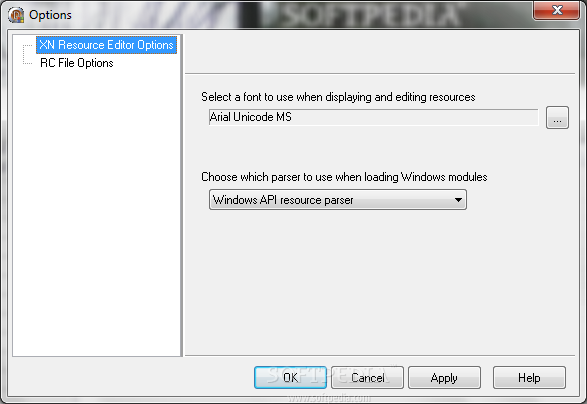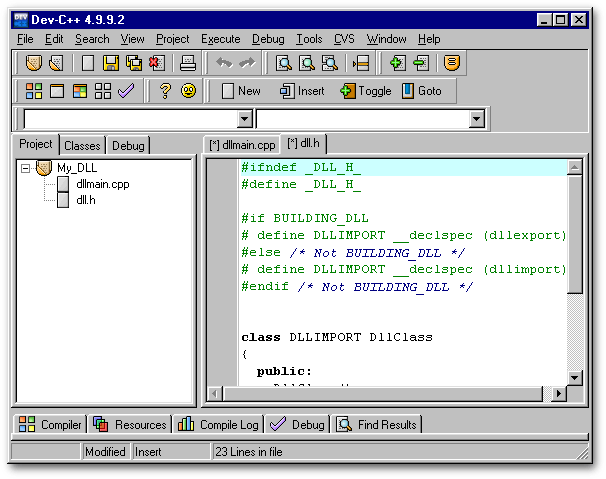To create a resource script file Put focus on your existing project folder in Solution Explorer, for example, MyProject. In the menu, go to Project Add New Item. Select the Visual C folder and choose Resource File (.rc) in the right pane. Provide a name for your resource script file in the. Adding a resource file manually in Dev-Cpp. Ask Question. Settings.rc is the resource file that im trying to add. C windows winapi makefile resources.
- Cda Resource File Examples
- Dev C++ Programs
- How To Add Resource File In Dev C Free
- How To Add Resource File In Dev C Online
Because XML resource (.resx) files must consist of well-defined XML, including a header that must follow a specific schema followed by data in name/value pairs, you may find that creating these files manually is error-prone. As an alternative, you can create .resx files programmatically by using types and members in the .NET Class Library. You can also use the .NET Class Library to retrieve resources that are stored in .resx files. This article explains how you can use the types and members in the System.Resources namespace to work with .resx files.
This article discusses working with XML (.resx) files that contain resources. For information on working with binary resource files that have been embedded in assemblies, see ResourceManager.
Warning
There are also ways to work with .resx files other than programmatically. When you add a resource file to a Visual Studio project, Visual Studio provides an interface for creating and maintaining a .resx file, and automatically converts the .resx file to a .resources file at compile time. You can also use a text editor to manipulate a .resx file directly. However, to avoid corrupting the file, be careful not to modify any binary information that is stored in the file.
Create a .resx file
You can use the System.Resources.ResXResourceWriter class to create a .resx file programmatically, by following these steps:
Instantiate a ResXResourceWriter object by calling the ResXResourceWriter(String) method and supplying the name of the .resx file. The file name must include the .resx extension. If you instantiate the ResXResourceWriter object in a
usingblock, you do not explicitly have to call the ResXResourceWriter.Close method in step 3.Call the ResXResourceWriter.AddResource method for each resource you want to add to the file. Use the overloads of this method to add string, object, and binary (byte array) data. If the resource is an object, it must be serializable.
Call the ResXResourceWriter.Close method to generate the resource file and to release all resources. If the ResXResourceWriter object was created within a
usingblock, resources are written to the .resx file and the resources used by the ResXResourceWriter object are released at the end of theusingblock.
The resulting .resx file has the appropriate header and a data tag for each resource added by the ResXResourceWriter.AddResource method.
Warning
Do not use resource files to store passwords, security-sensitive information, or private data.
The following example creates a .resx file named CarResources.resx that stores six strings, an icon, and two application-defined objects (two Automobile objects). The Automobile class, which is defined and instantiated in the example, is tagged with the SerializableAttribute attribute.

Tip
You can also use Visual Studio to create .resx files. At compile time, Visual Studio uses the Resource File Generator (Resgen.exe) to convert the .resx file to a binary resource (.resources) file, and also embeds it in either an application assembly or a satellite assembly.
You cannot embed a .resx file in a runtime executable or compile it into a satellite assembly. You must convert your .resx file into a binary resource (.resources) file by using the Resource File Generator (Resgen.exe). The resulting .resources file can then be embedded in an application assembly or a satellite assembly. For more information, see Creating Resource Files.
Enumerate resources
In some cases, you may want to retrieve all resources, instead of a specific resource, from a .resx file. To do this, you can use the System.Resources.ResXResourceReader class, which provides an enumerator for all resources in the .resx file. The System.Resources.ResXResourceReader class implements IDictionaryEnumerator, which returns a DictionaryEntry object that represents a particular resource for each iteration of the loop. Its DictionaryEntry.Key property returns the resource's key, and its DictionaryEntry.Value property returns the resource's value.
The following example creates a ResXResourceReader object for the CarResources.resx file created in the previous example and iterates through the resource file. It adds the two Automobile objects that are defined in the resource file to a System.Collections.Generic.List<T> object, and it adds five of the six strings to a SortedList object. The values in the SortedList object are converted to a parameter array, which is used to display column headings to the console. The Automobile property values are also displayed to the console.
Retrieve a specific resource
In addition to enumerating the items in a .resx file, you can retrieve a specific resource by name by using the System.Resources.ResXResourceSet class. The ResourceSet.GetString(String) method retrieves the value of a named string resource. The ResourceSet.GetObject(String) method retrieves the value of a named object or binary data. The method returns an object that must then be cast (in C#) or converted (in Visual Basic) to an object of the appropriate type.
The following example retrieves a form's caption string and icon by their resource names. It also retrieves the application-defined Automobile objects used in the previous example and displays them in a DataGridView control.
Convert .resx files to binary .resources files
Converting .resx files to embedded binary resource (.resources) files has significant advantages. Although .resx files are easy to read and maintain during application development, they are rarely included with finished applications. If they are distributed with an application, they exist as separate files apart from the application executable and its accompanying libraries. In contrast, .resources files are embedded in the application executable or its accompanying assemblies. In addition, for localized applications, relying on .resx files at run time places the responsibility for handling resource fallback on the developer. In contrast, if a set of satellite assemblies that contain embedded .resources files has been created, the common language runtime handles the resource fallback process.
To convert a .resx file to a .resources file, you use the Resource File Generator (Resgen.exe), which has the following basic syntax:

Resgen.exe.resxFilename
The result is a binary resource file that has the same root file name as the .resx file and a .resources file extension. This file can then be compiled into an executable or a library at compile time. If you are using the Visual Basic compiler, use the following syntax to embed a .resources file in an application's executable:
vbcfilename.vb -resource:.resourcesFilename
If you are using C#, the syntax is as follows:
cscfilename.cs -resource:.resourcesFilename
The .resources file can also be embedded in a satellite assembly by using Assembly Linker (AL.exe), which has the following basic syntax:
alresourcesFilename-out:assemblyFilename
See also
-->Note
Since projects in .NET programming languages do not use resource script files, you must open your resources from Solution Explorer. Use the Image editor and the Binary editor to work with resource files in managed projects.
Any managed resources you want to edit must be linked resources. The Visual Studio resource editors do not support editing embedded resources.
Cda Resource File Examples
The term resource file can refer to a number of file types, like:
The resource script (.rc) file of a program.
A resource template (.rct) file.
An individual resource existing as a stand-alone file. This type includes a bitmap, icon, or cursor file that's referred to from an .rc file.
A header file generated by the development environment. This type includes
Resource.h, that's referred to from an .rc file.
Resources found in other file types such as .exe, .dll, and .res files are referred to as resources.
You can work with resource files and resources from within your project. You can also work with ones that aren't part of the current project or were created outside the development environment of Visual Studio. For example, you can:
Work with nested and conditionally included resource files.
Update existing resources or convert them to Visual C++.
Import or export graphic resources to or from your current resource file.
Include shared or read-only identifiers (symbols) that can't be modified by the development environment.
Include resources in your executable (.exe) file that don't need editing (or shouldn't be edited), such as shared resources between several projects.
Include resource types not supported by the development environment.
For more information on resources, see how to Create Resources, Manage Resources, and Include Resources at Compile Time.
Editable Resources
The following types of files can be opened to edit the resources they contain:
| File name | Description |
|---|---|
| .rc | Resource script files |
| .rct | Resource template files |
| .res | Resource files |
| .resx | Managed resource files |
| .exe | Executable files |
| .dll | Dynamic-link library files |
| .bmp, .ico, .dib, .cur | Bitmap, icon, toolbar, and cursor files |
When editing resources, the Visual Studio environment works with and affects the following files:
| File name | Description |
|---|---|
| Resource.h | Header file generated by the development environment that contains symbol definitions. Include this file in source control. |
| Filename.aps | Binary version of the current resource script file used for quick loading. Resource editors don't directly read .rc or resource.h files. The resource compiler compiles them into .aps files that are consumed by the resource editors. This file is a compile step and only stores symbolic data. As with a normal compile process, information that isn't symbolic, such as commenting, is discarded during the compile process. Whenever the .aps file is out of synch with the .rc file, the .rc file is regenerated. For example, when you Save, the resource editor overwrites the .rc file and the resource.h file. Any changes to the resources themselves remain incorporated in the .rc file, but comments will always be lost once the .rc file is overwritten. For information on how to preserve comments, see Include Resources at Compile Time. Typically, you shouldn't include the .aps file in source control. |
| .rc | Resource script file that contains script for the resources in your current project. This file is overwritten by the .aps file whenever you save. Include this file in source control. |
Manifest Resources
In C++ desktop projects, manifest resources are XML files that describe the dependencies an application uses. For example, in Visual Studio this MFC wizard-generated manifest file defines which version of the Windows common control DLLs the application should use:
For a Windows XP or Windows Vista application, the manifest resource should specify the most current version of the Windows common controls for the application to use. The example above uses version 6.0.0.0, which supports the Syslink control.
Note
You can only have one manifest resource per module.
To view the version and type information contained in a manifest resource, open the file in an XML viewer or the Visual Studio text editor. If you open a manifest resource from Resource View, the resource will open in binary format.
To open a manifest resource
Dev C++ Programs
Open your project in Visual Studio and navigate to Solution Explorer.
Expand the Resource Files folder, then:
To open in the text editor, double-click the .manifest file.
To open in another editor, right-click the .manifest file and select Open With. Specify the editor to use and select Open.
How To Add Resource File In Dev C Free
Requirements
Win32
See also
How To Add Resource File In Dev C Online
Working with Resource Files
Resource Identifiers (Symbols)
Resource Editors